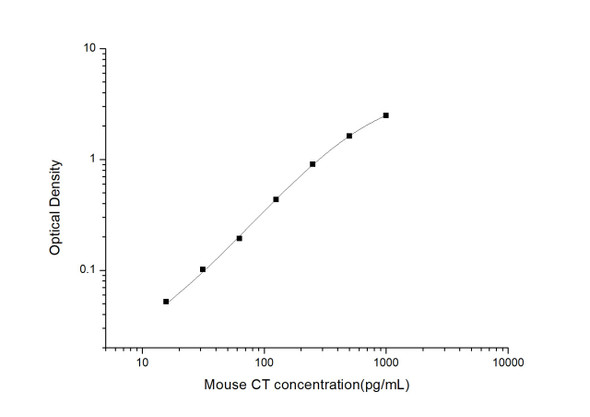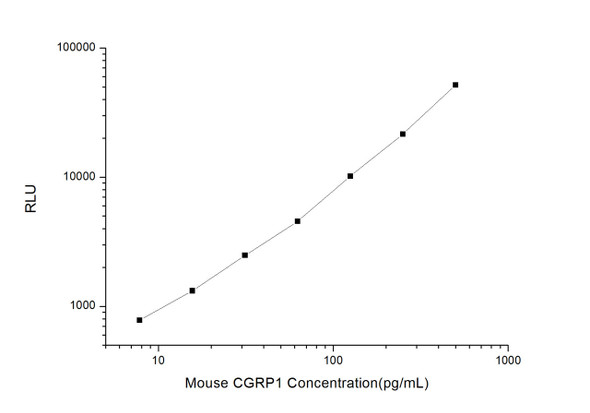Mouse Cell Signalling ELISA Kits 2
Mouse CT (Calcitonin) CLIA Kit (MOES00136)
- SKU:
- MOES00136
- Product Type:
- ELISA Kit
- ELISA Type:
- CLIA Kit
- Size:
- 96 Assays
- Sensitivity:
- 4.69pg/mL
- Range:
- 7.81-500pg/mL
- ELISA Type:
- Sandwich
- Synonyms:
- Thyrocalcitonin
- Reactivity:
- Mouse
- Sample Type:
- Serum, plasma and other biological fluids
Description
| Assay type: | Sandwich |
| Format: | 96T |
| Assay time: | 4.5h |
| Reactivity: | Mouse |
| Detection method: | Chemiluminescence |
| Detection range: | 7.81-500 pg/mL |
| Sensitivity: | 4.69 pg/mL |
| Sample volume: | 100µL |
| Sample type: | Serum, plasma and other biological fluids |
| Repeatability: | CV < 15% |
| Specificity: | This kit recognizes Mouse CT in samples. No significant cross-reactivity or interference between Mouse CT and analogues was observed. |
This kit uses Sandwich-CLIA as the method. The micro CLIA plate provided in this kit has been pre-coated with an antibody specific to Mouse CT. Standards or samples are added to the appropriate micro CLIA plate wells and combined with the specific antibody. Then a biotinylated detection antibody specific for Mouse CT and Avidin-Horseradish Peroxidase (HRP) conjugate are added to each micro plate well successively and incubated. Free components are washed away. The substrate solution is added to each well. Only those wells that contain Mouse CT, biotinylated detection antibody and Avidin-HRP conjugate will appear fluorescence. The Relative light unit (RLU) value is measured spectrophotometrically by the Chemiluminescence immunoassay analyzer. The RLU value is positively associated with the concentration of Mouse CT. The concentration of Mouse CT in the samples can be calculated by comparing the RLU of the samples to the standard curve.
| UniProt Protein Function: | CALCA: Calcitonin causes a rapid but short-lived drop in the level of calcium and phosphate in blood by promoting the incorporation of those ions in the bones. Belongs to the calcitonin family. 3 isoforms of the human protein are produced by alternative splicing. |
| UniProt Protein Details: | Protein type:Secreted; Secreted, signal peptide Chromosomal Location of Human Ortholog: 7 F1|7 59. 99 cM Cellular Component: axon; cell soma; cytoplasm; extracellular region; extracellular space; intracellular; neuron projection; nucleus; terminal button Molecular Function:calcitonin receptor binding; receptor binding Biological Process: adenylate cyclase activation; cellular calcium ion homeostasis; detection of temperature stimulus involved in sensory perception of pain; feeding behavior; G-protein signaling, adenylate cyclase activating pathway; inflammatory response; negative regulation of blood pressure; negative regulation of neurological process; negative regulation of ossification; negative regulation of smooth muscle contraction; neuromuscular junction development; neuropeptide signaling pathway; positive regulation of cell adhesion; positive regulation of ossification; regulation of blood pressure; regulation of heart contraction; regulation of heart rate; regulation of systemic arterial blood pressure by neurological process; response to heat; response to pain; sperm capacitation; vasodilation; vasodilation of artery during baroreceptor response to increased systemic arterial blood pressure |
| NCBI Summary: | This gene encodes the peptide hormones calcitonin, calcitonin gene-related peptide (CGRP) and katacalcin. Alternative splicing of the mRNA results in multiple variants that encode either calcitonin or CGRP preproproteins. Post-translational processing of the calcitonin and CGRP propeptides results in either calcitonin and katacalcin, or CGRP, respectively. Calcitonin and katacalcin modulate calcium levels in the blood stream. CGRP can function as a vasodilator and play a role in the transmission of pain. The human homolog of CGRP was found to have antimicrobial activity. [provided by RefSeq, Mar 2015] |
| UniProt Code: | P70160 |
| NCBI GenInfo Identifier: | 2493431 |
| NCBI Gene ID: | 12310 |
| NCBI Accession: | P70160. 1 |
| UniProt Secondary Accession: | P70160,Q8K1K5, |
| UniProt Related Accession: | P70160,Q99JA0 |
| Molecular Weight: | 14. 7kDa |
| NCBI Full Name: | Calcitonin |
| NCBI Synonym Full Names: | calcitonin/calcitonin-related polypeptide, alpha |
| NCBI Official Symbol: | Calca |
| NCBI Official Synonym Symbols: | CA; Ct; Ctn; Calc; Cgrp; CGRP1; Calc1; CGRP-1 |
| NCBI Protein Information: | calcitonin gene-related peptide 1 |
| UniProt Protein Name: | Calcitonin |
| UniProt Gene Name: | Calca |
As the RLU values of the standard curve may vary according to the conditions of the actual assay performance (e. g. operator, pipetting technique, washing technique or temperature effects), the operator should establish a standard curve for each test. Typical standard curve and data is provided below for reference only.
| Concentration (pg/mL) | RLU | Average | Corrected |
| 500 | 48652 54422 | 51537 | 51508 |
| 250 | 18922 23074 | 20998 | 20969 |
| 125 | 9927 8865 | 9396 | 9367 |
| 62.5 | 4165 4859 | 4512 | 4483 |
| 31.25 | 2426 2172 | 2299 | 2270 |
| 15.63 | 1339 1161 | 1250 | 1221 |
| 7.81 | 712 768 | 740 | 711 |
| 0 | 28 30 | 29 | -- |
Precision
Intra-assay Precision (Precision within an assay): 3 samples with low, mid range and high level Mouse CT were tested 20 times on one plate, respectively.
Inter-assay Precision (Precision between assays): 3 samples with low, mid range and high level Mouse CT were tested on 3 different plates, 20 replicates in each plate.
| Intra-assay Precision | Inter-assay Precision | |||||
| Sample | 1 | 2 | 3 | 1 | 2 | 3 |
| n | 20 | 20 | 20 | 20 | 20 | 20 |
| Mean (pg/mL) | 24.39 | 62.25 | 226.77 | 26.33 | 65.32 | 240.69 |
| Standard deviation | 2.37 | 5.05 | 15.67 | 2.71 | 5.83 | 23.64 |
| C V (%) | 9.72 | 8.11 | 6.91 | 10.29 | 8.93 | 9.82 |
Recovery
The recovery of Mouse CT spiked at three different levels in samples throughout the range of the assay was evaluated in various matrices.
| Sample Type | Range (%) | Average Recovery (%) |
| Serum (n=5) | 90-105 | 96 |
| EDTA plasma (n=5) | 100-113 | 107 |
| Cell culture media (n=5) | 86-99 | 92 |
Linearity
Samples were spiked with high concentrations of Mouse CT and diluted with Reference Standard & Sample Diluent to produce samples with values within the range of the assay.
| Serum (n=5) | EDTA plasma (n=5) | Cell culture media (n=5) | ||
| 1:2 | Range (%) | 97-113 | 94-108 | 102-114 |
| Average (%) | 104 | 102 | 108 | |
| 1:4 | Range (%) | 89-103 | 97-109 | 86-98 |
| Average (%) | 97 | 102 | 93 | |
| 1:8 | Range (%) | 100-111 | 100-112 | 84-98 |
| Average (%) | 105 | 106 | 90 | |
| 1:16 | Range (%) | 99-112 | 94-109 | 91-105 |
| Average (%) | 105 | 102 | 99 |
An unopened kit can be stored at 4°C for 1 month. If the kit is not used within 1 month, store the items separately according to the following conditions once the kit is received.
| Item | Specifications | Storage |
| Micro CLIA Plate(Dismountable) | 8 wells ×12 strips | -20°C, 6 months |
| Reference Standard | 2 vials | |
| Concentrated Biotinylated Detection Ab (100×) | 1 vial, 120 µL | |
| Concentrated HRP Conjugate (100×) | 1 vial, 120 µL | -20°C(shading light), 6 months |
| Reference Standard & Sample Diluent | 1 vial, 20 mL | 4°C, 6 months |
| Biotinylated Detection Ab Diluent | 1 vial, 14 mL | |
| HRP Conjugate Diluent | 1 vial, 14 mL | |
| Concentrated Wash Buffer (25×) | 1 vial, 30 mL | |
| Substrate Reagent A | 1 vial, 5 mL | 4°C (shading light) |
| Substrate Reagent B | 1 vial, 5 mL | 4°C (shading light) |
| Plate Sealer | 5 pieces | |
| Product Description | 1 copy | |
| Certificate of Analysis | 1 copy |
- Set standard, test sample and control (zero) wells on the pre-coated plate and record theirpositions. It is recommended to measure each standard and sample in duplicate. Note: addall solutions to the bottom of the plate wells while avoiding contact with the well walls. Ensuresolutions do not foam when adding to the wells.
- Aliquot 100 µL of standard solutions into the standard wells.
- Add 100 µL of Sample / Standard dilution buffer into the control (zero) well.
- Add 100 µL of properly diluted sample (serum, plasma, tissue homogenates and otherbiological fluids. ) into test sample wells.
- Cover the plate with the sealer provided in the kit and incubate for 90 min at 37 °C.
- Aspirate the liquid from each well, do not wash. Immediately add 100 µL of BiotinylatedDetection Ab working solution to each well. Cover the plate with a plate seal and gently mix. Incubate for 1 hour at 37 °C.
- Aspirate or decant the solution from the plate and add 350 µL of wash buffer to each welland incubate for 1-2 minutes at room temperature. Aspirate the solution from each well andclap the plate on absorbent filter paper to dry. Repeat this process 3 times. Note: a microplatewasher can be used in this step and other wash steps.
- Add 100 µL of HRP Conjugate working solution to each well. Cover with a plate seal andincubate for 30 min at 37 °C.
- Aspirate or decant the solution from each well. Repeat the wash process for five times asconducted in step 7.
- Add 100 µL of Substrate mixture solution to each well. Cover with a new plate seal andincubate for no more than 5 min at 37 °C. Protect the plate from light.
- Determine the RLU value of each well immediately.






